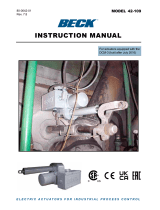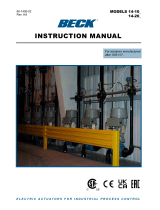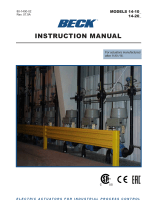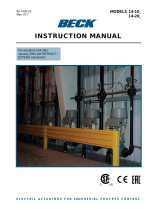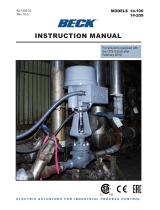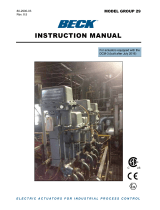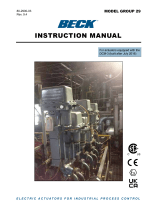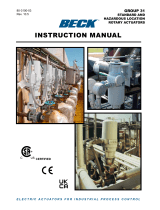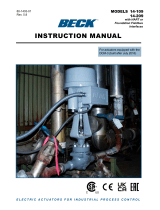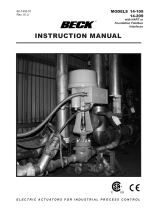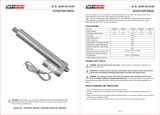Page is loading ...

80-0042-00
Rev. 8.4
INSTRUCTION MANUAL
42-107
42-105
42-103
MODELS
R
ELECTRIC ACTUATORS FOR INDUSTRIAL PROCESS CONTROL

2
80-0042-00, Rev. 8.4
Product Description ........................................................................................................3
General Specications ..................................................................................................4
Outline Dimensions ....................................................................................................... 6
Installation ........................................................................................................................7
Power and Signal Wiring ...............................................................................................7
Safety Precautions ...................................................................................................... 10
Start-up Instructions .................................................................................................... 11
Calibration ......................................................................................................................12
Travel Limit Switch Adjustment ...................................................................................12
Setting Auxiliary Switches ...........................................................................................14
Changing Direction of Travel .......................................................................................15
Feedback Signal .........................................................................................................16
Demand Input Signal...................................................................................................18
Loss of Signal Function ...............................................................................................19
Deadband Adjustment .................................................................................................20
Short-stroke Operation (Reducing Full Stroke Travel Distance) ................................. 20
Maintenance ...................................................................................................................21
Component Replacement ...........................................................................................21
Troubleshooting ..........................................................................................................22
Services ..........................................................................................................................23
Warranty .........................................................................................................................23
TABLE OF CONTENTS

3
80-0042-00, Rev. 8.4
INTRODUCTION
Beck’s Group 42 actuators are designed to
meet the actuation needs of long stroke linear
applications. Typical applications include burner
air registers and OFA port dampers, but they can
be used on any application requiring up to 18
inches of linear stroke. Employing Beck’s unique
design characteristics, reliability and quality into
a long stroke linear actuator design lls a much
requested slot in the Beck family of products.
As with all Beck actuators, the Group 42 is
designed for simple installation, no duty cycle
limitations, excellent performance and little or no
required maintenance.
Ideally suited for harsh industrial environments,
the Group 42 handles long stroke applications
requiring up to 1,000 lbs. (4 450 N) of thrust. The
design employs a highly ecient ball screw coupled
with a time-proven Beck motor and oers consistent,
repeatable positioning as precise as 0.25% of span.
Like all Beck actuators, the Group 42 incorporates
a heavy-duty, weather-proof, cast aluminum body.
HAZARDOUS LOCATION
ACTUATORS FOR DUST AREA
CLASSIFICATIONS (OPTIONAL)
Group 42 Actuators are available approved
for the following Protection Methods and
Protection Concepts, suitable for use in:
Class II, Division 1, Groups E, F and G; T3C
Class II, Division 2, Groups F & G; T3C
Class III, Division 1 & 2
Enclosure type 4X
Enclosure rated IP66
Tambient = –30ºC. to 70ºC. (120V operation)
–30ºC. to 60ºC. (240V operation)
PRODUCT DESCRIPTION

4
80-0042-00, Rev. 8.4
GENERAL SPECIFICATIONS
Actuator Power 120 V ac, single-phase, 50 or 60 Hz
Allowable Tolerance +10% / -15%
Max. Current & Power 1.2A, 144W @ 120 V ac
Output Thrust and Timing 1,000 lbs (4 450 N), 4.2 sec/in (1.65 sec/mm)
Stroke Range 5 to 18 inches (127 to 457 mm)
Weight Approx. 71 lbs (32.2 kg), depending on selected options.
Operating Conditions –40° to 85° C. (–40° to 185° F.)
0 to 100% relative humidity, non-condensing
Control Options Three types of control are available:
1) Open/close option 3. Two position control using manual
pushbuttons or an automatic controller.
2) Direct ac control option 5. Actuator is energized by 120 V ac
line current from a remote controller or manual switches.
3) Modulating analog control option 7. Onboard actuator control
electronics position output proportionally to mA Demand input
signal.
Demand Input Signal 4–20 mA or 1–5 V dc
(Option 7)
Deadband 1.0% of Span
Minimum Step .25% of Span
Hysteresis .5% of Span at any point
Position Feedback Signal 4–20 mA or 1–5 V dc
(Options 5 & 7)
Feedback may be congured as a two wire transmitter or as a four wire active signal source.
Two wire systems require a customer supplied external power supply. Four wire systems
require 120 V ac supply to the actuator.
Isolation Demand input and position Feedback signals are isolated from
ground and the ac power line. Signal buering provides 24 V dc
isolation between the signals.
Action on Loss of Power Stays in place.
PRODUCT DESCRIPTION

5
80-0042-00, Rev. 8.4
Action on Loss of Demand Stays in place or moves to predetermined position with ac power
Input Signal (Option 7) supplied.
Stall Protection (Option 7) If the motor tries to run in one direction for more than approx. 136
seconds, it will shut o.
Stall Relay Contacts Form A, 10 volt-amps at 120 V ac or dc
(Option 7)
Action on Stall (Option 7) Motor power is turned o when relay contacts open (after 136
seconds of stall). Remote signal is available.
Travel Limit Switches Two Form C (Retract and Extend), eld-adjustable.
Rated 10 A, 125/150 Vac; .5 A, 125 Vdc; .25 A, 150 Vdc.
Auxiliary Switches Two Form C rated for 1 A, 250 V ac., eld-adjustable.
Rated 10 A, 125/150 Vac; .5 A, 125 Vdc; .25 A, 150 Vdc.
Handswitch (Option 7) Permits local electrical operation, independent of Demand input
signal.
Handwheel Provides manual operation without electrical power.
Customer Wiring Terminals accommodate up to 12 AWG (3.31 mm2).
Motor 120 V ac, single-phase, no burnout, non-coasting. Capable of 60
starts per minute.
Enclosure Precision-machined aluminum alloy, painted with corrosion-
resistant polyurethane paint, to provide a rugged, dust-tight,
weatherproof enclosure. Type 4X; IP66.* Actuators designed for
hazardous locations are also available.
Mounting Orientation Can be mounted in any orientation.
Standards* CSA Labeled (US & Canada); CE Compliant; UKCA Compliant
*NOTE: May not be available with all options and models. For more information, please call Beck at 215-968-4600.

6
80-0042-00, Rev. 8.4
FRONT VIEW REAR VIEW
MODEL 42-107, -105 & -103 SPECIFICATIONS
(All dimensions are in inches and [mm] and are subject to change)
RIGHT SIDE VIEW
Note:
Front mounting clevis rotates 360°.
Custom rear clevis extensions are available.
Max. Actuator
Travel (in) [mm]
Min. Actuator
Travel (in) [mm]
"L" Dim. Fully
Ret. (in) [mm]
"L" Dim. Fully
Ext. (in) [mm]
Approx. Wt.
(lbs) [kgs]
8 [203] 5 [127] 18 19/32 [472] 26 19/32 [675] 64 [29]
12 [305] 7 [178] 22 19/32 [574] 34 19/32 [879] 66 [30]
18 [457] 11 [279] 28 19/32 [726] 46 19/32 [1 183] 69 [31]
2 17/32"
DIA.
[64]
7 25/32"
[198]
8 7/32"
[209]
ALLOW 2 3/4" [70]
FOR REMOVAL
2 1/4"
[57]
3 11/32"
[85]
"L" DIMENSION
3/8 [10]
1 1/16"
[27]
(SEE TABLE)
REAR CLEVIS
HOLE DIAMETER
1"
[25]
(SEE TABLE)
FRONT CLEVIS
HOLE DIAMETER
16"
[406]
ALLOW 6" [152]
FOR REMOVAL
11/16"
[17]
3/4"
[19]
3/4" N.P.T. CONDUIT
POWER CONNECTION
3/4" N.P.T. CONDUIT
SIGNAL CONNECTION
Available Front & Rear
Clevis Hole Diameters
.504 ± .003 [12.80 ± 0.76]
.754 ± .003 [19.15 ± 0.76]
.879 ± .003 [22.33 ± 0.76]
3 1/2"
[89]
.625
±.010
[15.875
.254]
4 15/32"
[114]
7 15/16"
[202]
3 13/16"
[97]
4 31/32"
[126]
3 13/32"
[87]
2 5/8"
[67]
3/4"
[19]
7 15/16"
[202]
1 15/32"
[37]
3 1/2"
[89]
3 7/16"
[87]
.625
±.010
[15.875
.254]
OUTLINE DIMENSION DRAWINGS

7
80-0042-00, Rev. 8.4
POWER AND SIGNAL WIRING
The Group 42 actuator has a pair of 3/4"
NPT threaded holes for signal and power conduit
connection. Temporary plugs are installed in the
conduit entrances at the factory for shipping only
and are not intended for permanent use.
Conduits should be routed from below
the actuator so that condensation and other
contaminants flow away from the conduit. Prior
to actuator operation, all conduit entrances must
be properly sealed in accordance with National
Standards or Regulatory Authorities.
Power and signal wires must be routed to the
actuator separately and be either shielded cables
or installed in conductive conduit and/or cable
trays.
All signal and power connections are made
on the terminal board. Typical wiring connections
for each Group 42 control option are described
on the following pages. A specic wiring diagram
is axed to each actuator shipped.
All actuators are furnished with two auxiliary
switches. Wiring connections for these are
described separately. In addition, a safety
ground is required for all actuators and is located
on the baseplate of the control module.
NOTE: Customer wiring inside the control
module must be properly dressed and routed
to prevent damage to wires from the control
module cover.
Figure 1
INSTALLATION
(Option 7 Terminal Board Shown)
Figure 1

8
80-0042-00, Rev. 8.4
Auxiliary Switches
Customer connections to the auxiliary switches are on the terminal board. Switch 1 connects to terminals
6, 7 and 8. Switch 2 connects to terminals 3, 4 and 5. Each switch is form C, rated for 1 amp at 120 V ac.
There is no electrical connection between the two switches. S1 is factory set to operate 2% of the travel
range before the Retract travel limit. S2 is factory set to operate 2% before the Extend travel limit. See page
14 for additional information about setting the auxiliary switches.
Option 7, Modulating
Analog Position Control with Loop Powered Position Feedback Signal
Customer must supply two wires to power the actuator: One 120 V ac line (terminal 1), and one neutral
(terminal 2). Customer must supply two wires for the analog input control signal: Connect to terminal 11 (-) and
to terminal 12 (+). The loop powered position feedback signal must be connected to a “2-wire” type analog input
that provides a dc voltage over the signal wires (a dc voltage power supply must be wired in series with the signal
wiring). If the dc supply is 24 to 35 volts, connect to terminal 14 (-) and to terminal 15 (+). If the dc power supply
is 36 to 45 volts, reverse polarity and connect to terminal 14 (+) and to terminal 15 (-).
Analog Position Control with Actuator Powered Position Feedback Signal
Customer must supply two wires to power the actuator: One 120 V ac line (terminal 1), and one neutral
(terminal 2). Customer must supply two wires for analog control: Connect to terminal 11 (-) and to terminal
12 (+). Customer may supply two additional wires to monitor the analog position feedback signal: Connect to
terminal 13 (-) and to terminal 14 (+). The actuator’s feedback circuit power supply is derived from the 120 V
ac line, therefore the feedback signal must be wired to a "4-wire" type, non-powered analog input.
78
6
45
3
S1
S2
INSTALLATION
Typical Wiring Diagram (Option 7)

9
80-0042-00, Rev. 8.4
Option 5, Modulating
Direct AC Control with Loop Powered Position Feedback Signal
Customer must supply three wires to directly control the actuator motor direction: One 120 V ac line
to run Extend (terminal 10), one 120 V ac line to run Retract (terminal 9), and one neutral (terminal 2).
Customer may supply two additional wires to monitor a loop powered position feedback signal. The loop
powered position feedback signal must be connected to a “2-wire” type analog input that provides a dc
voltage over the signal wires (a dc voltage power supply must be wired in series with the signal wiring). If
the dc supply is 24 to 35 volts, connect to terminal 14 (-) and to terminal 15 (+). If the dc supply is 36 to 45
volts, reverse polarity and connect to terminal 14 (+) and to terminal 15 (-).
Direct AC Control with Actuator Powered Position Feedback Signal
Customer must supply three wires to directly control the actuator motor direction: One 120 V ac line
to run Extend (terminal 10), one 120 V ac line to run Retract (terminal 9), and one neutral (terminal 2).
Customer may supply two additional wires to monitor the analog position feedback signal: Connect to
terminal 13 (-) and to terminal 14 (+). If position feedback monitoring is desired, a 120 V ac line must be
connected to terminal 1. The actuator’s feedback circuit power supply is derived from this 120 V ac line,
therefore the feedback signal must be wired to a “4-wire” type, non-powered analog input.
Option 3, Open/Close
Direct AC Control
Customer must supply three wires to directly control the actuator motor direction: one 120 V ac line to run
Extend (terminal 10), one 120 V ac line to run Retract (terminal 9) and one neutral (terminal 2).
Typical Wiring Diagram (Option 5)
Typical Wiring Diagram (Option 3)

10
80-0042-00, Rev. 8.4
Power and signal wires must be routed to the
actuator separately and be either shielded cables
or installed in conductive conduit and/or cable trays.
Shielded, twisted pair cables should be used
for signal connections to avoid being aected by
electrical noise. These signal wires, based on Noise
Susceptibility Level (NSL) per IEEE-518, fall into the
level 1 classication. A braided shield will be more
eective than a wrapped foil shield. Signal wire
shields should be connected to the actuator casting
grounding screw. If grounding at the signal source
is required, then the shield should not be grounded
at the actuator. Raceways such as conduits and
trays have to be grounded at both ends to properly
meet immunity requirements.
A large, clearly labeled terminal block in the
actuator is enclosed in a separate, gasketed metal
enclosure. Terminals will accommodate up to 12
AWG (3.31 mm2) wiring.
CAUTION
Always close covers immediately
after installation or service to prevent
moisture or other foreign matter
from entering the actuator.
Refer to the wiring diagram furnished with your
Beck actuator for proper AC power and signal
connections. It is advisable to provide normal short
circuit protection on the AC power line. A copy of
the wiring diagram is shipped with each actuator
and is fastened to the inside of the terminal block
cover. If there is no wiring diagram available, you
may obtain a copy from Beck by providing the serial
number of your actuator.
Your Beck actuator has been supplied to match
the signal source in your control loop. If it does not
match, a 250 ohm input resistor may be added or
removed to obtain the proper match. Consult the
factory for details.
For maximum safety, and to comply with
national and international standards, the Beck
actuator body is required to be grounded. Use
one of the two grounding terminals in the wiring
compartment of the actuator to make this
connection. Wire size 12 AWG (3.31 mm2) is
recommended for this purpose.
CONDUIT ENTRIES
Conduits are provided for power and signal
wiring. Temporary plugs are installed in the
conduits at the factory for shipping only and are
not intended for permanent use. Prior to actuator
operation, all conduit entrances must be properly
sealed in accordance with National Standards or
Regulatory Authorities.
SAFETY PRECAUTIONS
WARNINGWARNING
Installation and service instructions
only. To avoid injury and electric
shock, do not perform any servicing
other than that contained in this
manual. Please read and understand
the appropriate sections in this
manual before attempting to install
or operate your actuator.
CAUTION
Hot surfaces! Surfaces of equipment
may be at an elevated temperature
depending on operating conditions
and environment. Allow to cool
before servicing.
STORAGE INFORMATION
Beck actuators should be stored in their shipping
cartons in a clean, dry area.
If it is necessary to store actuators outdoors for
a long period of time, they should be stored above
ground and covered with a waterproof cover. Do not
stack cartons. Stored actuators should be checked
periodically to ensure no condensation has formed
in electronic and terminal compartments. Moisture
damage while in storage is not covered by warranty.
UNPACKING
Group 42 actuators are shipped in standardized
cardboard shipping containers and secured to a
wooden platform.
INSTALLATION—ELECTRICAL
NOTE: All Beck actuators are shipped from
the factory ready for installation; no electrical
adjustments are required before placing them
in operation. Each actuator is set up and
that were written into the equipment order.
Two N.P.T. conduit connections are provided for
power and signal wiring to the actuator. One 3/4"
conduit is provided for signal wiring connections,
and the other 3/4" conduit is provided for power
and auxiliary switch connections. A sealant must
be used on threaded conduit connections to keep
moisture out. Conduits should be routed from
below the actuator so that condensation and other
contaminants entering the conduit cannot enter the
actuator.
INSTALLATION

11
80-0042-00, Rev. 8.4
START‑UP INSTRUCTIONS
After wiring and mounting, the actuator is
ready to be tested for proper operation.
Turn on the power supply.
For Options 3 & 5, turn on the actuator 120
V ac control signal and observe that the output
shaft travels through its desired stroke and moves
in the proper direction. If the direction of travel is
wrong, check the wiring connections and verify
that the control signal is correct at the actuator.
If the wiring and signal are correct, then reverse
the direction of shaft travel. See page 15 for
instructions.
For Option 7, set the Auto-Manual switch (S2)
to Manual. Using the Handswitch (S1), run the
actuator through its full stroke, rst extend then
retract (for location of switches S1 and S2, see
Figure 7, page 19). Observe that the output shaft
travels through its desired stroke. Note that the
“F” (extend) and “R” (retract) LEDs on the control
board light to indicate the direction of travel of the
output shaft. The LEDs remain lit when the unit is
stopped by the travel limit switches.
Set the Auto-Manual switch to Auto mode and
operate the actuator by varying the control signal.
Check that the output shaft travels in the proper
direction for a change in control signal. If it does
not, rst check the wiring connections and verify
that the control signal is correct at the actuator. If
the wiring and signal are correct, then reverse the
direction of travel. See page 15 for instructions.
Note that the “F” (extend) and “R” (retract) LEDs
light to indicate the direction the actuator output
shaft is moving and are not lit when the shaft stops
and the input and feedback signals are in balance.
When satisfied that the actuator travel is
correct with reference to the input signals, the unit
is ready to be placed in operation.

12
80-0042-00, Rev. 8.4
NOTE: Beck actuators are shipped ready
for installation—no calibration or switch
adjustments are required. The procedures
below are provided in the event that the
CALIBRATION HIERARCHY
The calibration hierarchy provides the
chronological order for performing calibration
procedures. If, for some reason, any or all of the
calibration procedures are required, they should be
performed in the order outlined below:
STEP 1: Adjust travel and auxiliary switches (see
pages 12–14).
STEP 2: Change direction of travel (see page 15).
STEP 3: (Options 5 & 7 only). Calibrate the position
feedback output signal (see page 17).
STEP 4: (Option 7 only) Calibrate the demand input
signal (see page 18).
TRAVEL LIMIT SWITCHES (S3, S4)
All Group 42 actuators are shipped from the
factory with the travel limit switches (S3 and S4)
adjusted to provide the full rated stroke range
unless a reduced stroke is specied at the time of
order. No adjustments are necessary unless the
full stroke length needs to be shortened to meet
dierent application requirements.
The travel limit switches are labeled S3 and S4,
and correspond to fully retracted and fully extended
positions respectively. These switches must be
set inside the mechanical stop limits to prevent
the actuator from stalling against the mechanical
stops. Depending on the control option ordered,
these switches serve slightly dierent purposes.
Control option 3 (42-103): S3 and S4 dene
the exact fully retracted and fully extended end of
travel point.
Control options 5 & 7 (42-105, 42-107): S3
and S4 provide electrical over-travel protection.
In these versions, the control electronics position
the output and determine the fully retracted and
extended positions during normal operation.
CAUTION
Do not attach the meter or attempt
to adjust the switch cams until the
actuator is discon nected from the
line voltage and auxiliary switches
are disconnected from external
power sources.
Setting the Retract Travel Limit
Switch (S3)
1. Remove the control module cover.
2. Retract the output shaft to the desired travel
limit. For Options 3 & 5, skip to step 3. For
Option 7: De-energize the motor by turning
toggle switch S1 (see Fig. 3) to stop (center
position). Turn the Handwheel until the
position feedback signal (measured across
terminals 14 (+) & 13 (–)) decreases by .005 ±
.001 mA (1.25 mV ± .25). The .005 mA is the
over-travel range. NOTE: If direction of travel
is set for retract on increasing demand, then
turn the Handwheel until the output signal
increases by .005 ± .001 mA (1.25 ± .25 mV).
3. Disconnect the power from the actuator.
4. a. For actuators with Option 3 or 5, connect
the continuity meter across terminals 2
and 9. Rotate the cam (see Fig. 2 next
page) until the meter shows an increase
in resistance from approx. 100 ohms to
more than 1 M ohms (switch contacts
open, switch clicks).
b. For actuators with Option 7, remove the
cable tie holding the switch wires, remove
the two wires from the retract limit switch
(second from the top), and attach the
meter across these contacts. Rotate the
cam (see Fig. 3 next page for method
only--shows S4 connected) until the meter
shows no continuity (switch contacts
open, switch clicks).
5. Disconnect the meter and reconnect switch
wires and actuator power.
6. Extend the output shaft away from the retract
travel limit. Note the direction of rotation of the
lobe of the cam. The correct cam lobe motion
is away from the switch lever and the switch
lever should be on the lower part of the cam.
If this is not correct, return to step 2 and reset
the cam to the proper orientation.
7. Retract the output shaft to the desired travel
limit. If the desired stopping point is reached,
the switch is properly set.
8. For Option 7, redress the switch wires and secure
to the control board stando with a cable tie.
9. Replace the control module cover.
S4
S3
CONTACTS CLOSED
CONTACTS OPEN
TRAVEL
LIMIT SWITCH
SETTINGS
For Option 5 & 7 Drives
switches are set .03” (±.01”)
beyond typical travel range
0% FULLY
RETRACTED
100% FULLY
EXTENDED
CALIBRATION

13
80-0042-00, Rev. 8.4
Setting the Extend Travel Limit
Switch (S4)
1. Remove the control module cover.
2. Extend the output shaft to the desired travel
limit. For Options 3 & 5, skip to step 3. For
Option 7: De-energize the motor by turning
toggle switch S1 (see Fig. 3) to stop (center
position). Turn the Handwheel until the
position feedback signal (measured across
terminals 14 (+) & 13 (–)) increases by .005 ±
.001 mA (1.25 mV ± .25). The .005 mA is the
over-travel range. NOTE: If direction of travel
is set for retract on increasing demand, then
turn the Handwheel until the output signal
decreases by .005 ± .001 mA (1.25 ± .25 mV).
3. Disconnect the power from the actuator.
4. a. For actuators with Option 3 or 5, connect
the continuity meter across terminals 2
and 10. Rotate the cam (see Fig. 2 at
right) until the meter shows an increase
in resistance from approx. 100 ohms to
more than 1 M ohms (switch contacts
open, switch clicks).
b. For actuators with Option 7, remove the
cable tie holding the switch wires, remove
the two wires from the extend limit switch
(top switch), and attach the meter across
these contacts. See Fig. 3 at right.
Rotate the cam (see Fig. 2 at right) until
the meter shows no continuity (switch
contacts open, switch clicks).
5. Disconnect the meter and reconnect switch
wires and actuator power.
6. Retract the output shaft and note the direction
that the Retract limit switch cam rotates. The
correct cam lobe motion is away from the
switch lever and the switch lever should be on
the lower part of the cam. If this is not correct,
return to step 2 and reset the cam to the proper
orientation.
7. Retract the output shaft to the desired travel
limit. If the desired stopping point is reached,
the switch is properly set.
8. For Option 7, redress the switch wires and secure
to the control board stando with a cable tie.
9. Replace the control module cover.
Adjust cam by inserting a small screwdriver
(or similarly sized tool) in one of the
adjustment slots and slowly rotating the cam.
Figure 2
Figure 3
Cam Adjustment
Cam Adjustment Slots
(any one may be used)
Meter connections for S4 switch
(Push on connectors shown
without wires for clarity)

14
80-0042-00, Rev. 8.4
The following procedure recommends the
use of a continuity meter to determine when the
auxiliary switch opens or closes. If such a meter
is not available, it is possible to hear the switch
click as the contacts open and close.
1. Remove the control module cover.
2. Move the output shaft to the desired switch
position.
3. Disconnect power from the actuator.
4. Connect the continuity meter across the
normally closed terminal on the terminal
board (terminals 6 and 7 for S1, and 3 and 4
for S2). Adjust the cam until the meter shows
no continuity (switch contacts open, switch
clicks). See Fig. 2, page 13.
5. Disconnect the meter and reconnect actuator
power.
6. Extend/Retract the output shaft in the
direction away from the switch position. Note
the direction of rotation of the lobe of the cam.
The correct cam lobe motion is away from
the switch lever and the switch lever should
be on the lower part of the cam. If this is not
correct, return to step 2 and reset the cam to
the proper orientation.
7. Reconnect the meter and actuator power.
8. Extend/Retract the output shaft again to the
desired switch position. If the contacts close,
the switch is properly set.
9. Replace the control module cover.
SETTING AUXILIARY SWITCHES
(S1 & S2)
All versions of Group 42 actuators referenced
in this manual are shipped with two auxiliary
switches. They may be set at any point in the
active range of actuator travel. Unless otherwise
specied at time of order, these switches are
factory set as follows:
Auxiliary switch S1 is set approximately 2%
(4.32 mA feedback) before the retract limit.
Auxiliary switch S2 is set approximately 2%
(19.68 mA feedback) before the extend limit.
The auxiliary switches are opened and closed
by cams that are driven by the actuator output
shaft. Setting the switch position involves moving
the actuator output shaft to the desired position
and adjusting the cam so that it just actuates the
switch at that point.
CAUTION
Do not attach the meter or attempt
to adjust the switch cams until the
actuator is discon nected from the
line voltage and auxiliary switches
are disconnected from external
power sources.
CALIBRATION
S1
S2
AUXILIARY
SWITCH SETTINGS
RETRACT
LIMIT
EXTEND
LIMIT
7
4
6
8
3
5
2% 98%
CONTACTS CLOSED
CONTACTS OPEN

15
80-0042-00, Rev. 8.4
CHANGING OUTPUT SHAFT
DIRECTION OF TRAVEL
Direction of travel is dened as the direction
of output shaft travel produced by an increasing
signal. Direction of travel is determined by
looking at the end of the output shaft. Unless
otherwise specified at the time of order, the
factory set output shaft travel is to extend in
response to an increasing signal.
The following procedure should be followed
to check or change the direction of travel of the
output shaft.
This is up to a three procedure process
depending on the actuator control option. The
procedures are as follows:
1. Interchange limit switch wires.
2. Calibrate position feedback signal.
3. Test/calibrate the Demand input signal.
CAUTION
Be sure the actuator is disconnected
from the line voltage and the auxiliary
switches are disconnected from
the external power sources before
proceeding with direction change
procedure.
Interchange Limit Switch Wires
1. Remove the control module cover.
2. To reverse the output shaft direction of travel,
the wires to the common terminals of travel
limit switches S3 and S4 must be interchanged.
The common terminals are those located
furthest from the switch labels and nearest
to the power transformer (see Figure 4, this
page).
3. For extend output shaft travel on an increasing
signal, the orange wire must be on the
common terminal of S4 and the brown wire on
the common terminal of S3.
4. For retract output shaft travel on an increasing
signal, the brown wire must be on the common
terminal of S4 and the orange wire must be on
the common terminal of S3.
5. Locate plug P4 on the control board. It is a
three wire plug with a grey, blue and yellow
wire attached to it. See Figure 6, page 18, for
the location of plug P4.
6. For extend output shaft travel on an increasing
signal, plug P4 must be attached to the
terminal labeled CW. Note that this is a locking
type plug and must be located properly in its
receptacle. The tapered side of the plug must
be against the tapered side of the receptacle.
See Option 5 or 7 wiring diagram, page 7 or 8.
7. For retract output shaft travel on an increasing
signal, this plug must be attached to the
terminal labeled CCW.
8. If the direction of travel of the output shaft is
changed; the feed back signal, the feedback
potentiometer, and (for Option 7) the input
signal must be recalibrated. See instructions
beginning on page 16.
9. End of procedure for the control option 3
actuator. For options 5 and 7, continue
to Feedback signal calibration procedure
(page 16).
Figure 4
Interchange the limit switch wires
(Push on connectors shown
without wires for clarity)

16
80-0042-00, Rev. 8.4
feedback calibrated for full output shaft travel unless
otherwise specified at time of order. Feedback
signal calibration is necessary to ensure that the
signal current or voltage correctly corresponds to
the actuator output shaft position.
CHANGING FEEDBACK SIGNAL TYPE
The feedback signal may be specied as 4-20
milliamps or 1-5 volts when ordered or it may be
changed at installation, using the following methods.
FOR OPTION 7: To convert a 4-20 milliamp
conguration to 1-5 volts, remove the diode from
position R2 on the terminal board and replace
FEEDBACK SIGNAL OPTIONS
(OPTIONS 5 & 7 ONLY)
The feedback signal is an analog voltage
or current signal proportional to the position
of the actuator’s output shaft. It may be used
for remote position indication or for automatic
control loop feedback. Actuators with Options 5
or 7 may be eld connected to function as a two
wire transmitter or as a four wire active current
source. This circuit conguration is determined
by the position of Jumper Plug J5/J6 located
on the control board (J-J5 for 2-wire, J-J6 for
4-wire). See Figure 6 or 7 for J5/J6 location.
Unless otherwise specied at the time of order,
all Group 42 actuators are shipped with the
feedback circuit congured as a 4-wire system.
Also, all Option 7 models are shipped with a
249 ohm resistor (R5) mounted between output
signal terminals 13 and 14. This resistor is used
to ensure proper operation of the control board
when the feedback signal is not connected to a
control room indicator. A summary of position
feedback options, output signal ranges and
control board and terminal board part numbers is
provided in TABLE 1, below.
FEEDBACK SIGNAL & CALIBRATION
For 4‑wire feedback only
All Group 42 actuators are shipped with the
Option 7 Terminal Board
Figure 5
TABLE 1
R4
F1
R3
VR2
VR1
TB1
TB2
22-4001-13
R2
1 2
1 2
TP2
15141312
TP1
11
1514
3 4
1312
10
5
9
6
3456
11
10
87
9
87
R1
R5
Fdbk. Control Signal Cong. Ext. Pwr.
Fdbk. Sig.
Conn. Jumper
Loc.
Max.
Ext.
Load
Input Fdbk. Input Output
Meter Conn. for
Signal Cal.
System Option Input Output Supply Plus Minus Res. R1 Res. R2 Res. Ω Res. Ω Plus Minus
Milliameter Connection
2-Wire 5120 V 4-20 mA <35 V 15 14 J-J5 300Ω -- Diode -- >1 M 14 Cust. - (Series)
2-Wire 5120 V 4-20 mA >36 V 14 15 J-J5 800Ω -- Open -- >1 M 15 Cust. - (Series)
2-Wire 71-5 V 4-20 mA <35 V 15 14 J-J5 300Ω -- Diode 2 M >1 M 14 Cust. - (Series)
2-Wire 71-5 V 4-20 mA >36 V 14 15 J-J5 800Ω -- Open 2 M >1 M 15 Cust. - (Series)
2-Wire 74-20 mA 4-20 mA <35 V 15 14 J-J5 300Ω 249Ω Diode 249 >1 M 14 Cust. - (Series)
2-Wire 74-20 mA 4-20 mA >36 V 14 15 J-J5 800Ω 249Ω Open 249 >1 M 15 Cust. - (Series)
*4-Wire 5120 V 4-20 mA 120 V 14 13 J-J6 500Ω -- Diode -- >1 M 14 Cust. + (Series)
4-Wire 71-5 V 4-20 mA 120 V 14 13 J-J6 500Ω -- Diode 2 M >1 M 14 Cust. + (Series)
*4-Wire 74-20 mA 4-20 mA 120 V 14 13 J-J6 500Ω 249Ω Diode 249 >1 M 14 Cust. + (Series)
Voltmeter Connection
4-Wire 5120 V 1-5 V 120 V 14 13 J-J6 0.4 mA -- 249Ω -- 249 14 13 (Parallel)
4-Wire 71-5 V 1-5 V 120 V 14 13 J-J6 0.4 mA -- 249Ω 2 M 249 14 13 (Parallel)
4-Wire 74-20 mA 1-5 V 120 V 14 13 J-J6 0.4 mA 249Ω 249Ω 2 M 249 14 13 (Parallel)
Control Option 5 = Control Board 22-4001-10 & Terminal Board 22-4001-07.
Control Option 7 = Control Board 22-4001-17 or 22-5001-21 (22-5001-21 supersedes 22-4001-17) & Terminal Board 22-4001-13.
Note: For Split Range Operation, 1-5 V dc input can be calibrated 1-3 or 3-5 V dc. 4-20 mA input can be calibrated 4-12 or 12-20 mA.
Maximum Input Common Mode Range +15 V to -5 V as measured from Terminal 11 to Terminal 13.
*Typical for most applications.
CALIBRATION

17
80-0042-00, Rev. 8.4
3. Set the Forward/Reverse toggle switch to STOP
(center position), Option 7 Control Board only.
4. Set the Manual/Automatic toggle switch to "M"
(Manual), Option 7 Control Board only.
5. Connect the meter to read the feedback signal.
FOR CURRENT FEEDBACK APPLICATIONS:
Connect the meter in series with the plus signal
line of the control room indicator and the plus
signal position (terminal 14 or 15; see TABLE 1
for correct meter polarity or reference the wiring
diagram inside the control cover).
FOR VOLTAGE FEEDBACK APPLICATIONS:
Connect the meter across the signal terminals 13
and 14. Terminal 14 is positive.
FOR INSTALLATIONS WITH NO REMOTE
INDICATOR: Remove the resistor from between
terminals 13 and 14 and connect the meter across
these terminals. Terminal 14 is positive.
6. Reverse plug connection P4. Note that plug
P4 is a locking type plug and must be located
properly in its receptacle. The tapered side of
the plug must be against the tapered side of
the receptacle. See Figure 6, page 18 for the
location of the plug. NOTE: On plug P4, CW =
Extend and CCW = Retract.
7. If the mechanical position of the feedback
potentiometer has not been set:
a. Move the actuator output shaft to the
(minimum input signal) position.
b. Disconnect all power to the actuator.
c. Loosen feedback potentiometer clamp
screws.
8. Turn trim potentiometer R38 clockwise 20
turns (to limit), then rotate it 8 full turns
counterclockwise.
9. Turn trim potentiometer R46 clockwise 20
turns (to limit), then rotate it 8 full turns
counterclockwise.
10. Reconnect actuator power.
11. Turn the feedback potentiometer until the
output signal reads 20 + 0.5 milliamps (5 + 0.1
volts on units congured for voltage output).
12. Tighten the feedback potentiometer clamp
screws to hold the potentiometer in position.
The potentiometer orientation is now
complete.
Signal Calibration
13. Turn trim potentiometer R46 counterclockwise
until the output signal reads 3.95 mA ± .001
mA (1 volt on units configured for voltage
output).
14. Move the output shaft towards the (maximum
input signal) position.
with a 249 ohm resistor. To convert a 1-5 volt
conguration to 4-20 milliamps, remove the 249
ohm resistor and replace it with a 12 volt zener
diode, Beck Part Number 13-2550-04. See
Figure 5, page 16, for location of resistor R2.
FOR OPTION 5: To convert a 4-20 milliamp
configuration to 1-5 volts, install a 249 ohm
resistor in position R2. To convert a 1-5 volt
conguration to 4-20 milliamps, remove the 249
ohm resistor from position R2.
FEEDBACK POTENTIOMETER AND
SIGNAL CALIBRATION PROCEDURE
When properly adjusted, the feedback signal
will be 20 milliamps (5 volts) with the actuator output
shaft in the 100% (maximum input signal) position.
At the 50% travel position, the signal should be
12 milliamps (3 volts) and at 0% (minimum input
signal) 4 milliamps (1 volt). NOTE: The endpoint
values are opposite if the direction of travel is set to
retract on an increasing signal.
The calibration procedure requires checking
and/or setting the feedback potentiometer and
two trim potentiometers located on the control
board. The following paragraphs describe the
procedure to check and set feedback signal
calibration.
NOTE: The travel limit switches must be
properly adjusted before the feedback signal
is calibrated. The feedback signal must be
calibrated before the input signal can be
calibrated.
Tools required for calibration:
mA/V dc voltmeter
3/32 inch screwdriver
Large screwdriver
TABLE 1 lists the meter connections required
for the calibration procedure.
Figures 6 and 7 show the location of the
jumper plug, feedback potentiometer, trim
potentiometers, the Forward/Reverse and
Manual/Automatic switches and plug P4 on the
control boards.
Orienting the Potentiometer
(Note: Only use Steps 2–12 when changing
direction of travel)
1. Remove the control module cover.
2. Position the actuator output shaft to the end of
travel that corresponds to 4 mA (i.e., to the fully
retracted position if the actuator travel is set to
extend on an increasing demand signal, or to
the fully extended position if the actuator travel
is set to retract). Allow the over-travel limit
switch to de-energize the motor at the limit.
Continued

18
80-0042-00, Rev. 8.4
travel, the input signal should be 12 milliamps (3
volts) and at fully retracted, 4 milliamps (1 volt).
Split signal operation is also possible. The
control board can be adjusted to produce full
actuator travel with 50% of the input signal,
permitting two actuators to respond independently
from the same signal source. Split signal ranges
are:
4 to 12 milliamps (1 to 3 volts)
12 to 20 milliamps (3 to 5 volts)
It is also possible to calibrate the control
board to give a span anywhere between 8 and 16
milliamps (2 to 4 volts), with the minimum signal
between 4 and 12 milliamps (1 to 3 volts). The
maximum input signal may be anywhere between
12 and 20 milliamps (3 to 5 volts) as long as the
span is at least 8 milliamps (2 volts).
Tools required for calibration:
mA/V dc voltmeter
3/32 inch screwdriver
Large screwdriver
Table 1 lists the meter connections required for
the calibration procedure.
The calibration procedure requires setting
two trim potentiometers R13 and R14 on the
control board. Figure 7 shows the location of
these potentiometers and the Manual/Automatic
switches.
1. Remove the control module cover.
2. Set the Manual/Automatic toggle switch to
AUTOMATIC.
3. Connect a signal source to terminals 11 and
12, positive to 12.
4. Connect the meter to read the feedback
signal in accordance with Table 1, page 16.
Option 5 Control Board
Figure 6
FEEDBACK
POTENTIOMETER
1
1
CCWCW
P4
P4
R38
R46
1
J6J5
J5 / J6
15. Position the actuator output shaft to the end
of travel limit that corresponds to 20 mA (i.e.,
to the fully extended position if the actuator
travel is set to extend on an increasing
demand signal, or to the fully retracted
position if the travel is set to retract). Allow
the over-travel limit switch to de-energize the
motor at the limit.
16. Turn trim potentiometer R38 counterclockwise
until the output signal is 20.05 mA ± .001
mA (5 volts on units congured for voltage
output).
17. Repeat steps 15 through 16 until the feedback
signal is calibrated. Adjusting R38 and R46
clockwise increases the signal while counter-
clockwise decreases the signal.
18. Reinstall resistor between terminals 13 and 14
(if used).
NOTE: The input signal is calibrated relative
to the feedback signal. Therefore the shaft
travel limit switches must be properly
adjusted and the feedback signal calibrated
before the input signal can be calibrated.
DEMAND INPUT SIGNAL CALIBRATION
(Option 7 only)
NOTE (Option 7): All actuators are fully
calibrated at the factory and should require
no adjustment; however, if necessary,
calibration may be tested as follows:
Apply 4.00 mA; actuator should position
at 4.00 mA ± .02 mA.
Apply 20.00 mA; actuator should position
at 20.00 mA ± .02 mA.
If adjustments are required, see below.
Input signal calibration is necessary to ensure
that the input signal correctly corresponds to the
position of the actuator output shaft.
Unless otherwise specified at the time of
order, all Group 42 actuators are shipped with the
input signal calibrated for full output shaft travel
and the input signal range set to 4 to 20 milliamps.
A 1 to 5 volt input signal may be specied at time
of order or changed at installation. To convert
a 4 -20 milliamp input conguration to 1-5 volts,
remove input resistor R1 from the terminal board.
To convert a 1-5 volt input conguration to 4-20
milliamps, install a 249 ohm resistor in position
R1. See Figure 5, page 16 for the location of R1.
When properly adjusted, the actuator output
shaft will be in the fully extended position when
the input signal is 20 milliamps (5 volts). At 50%
CALIBRATION

19
80-0042-00, Rev. 8.4
Continued
FOR INSTALLATIONS WITH NO REMOTE
INDICATOR: Remove the resistor from between
terminals 13 and 14 and connect the meter across
these terminals. Terminal 14 is positive.
5. Connect 120 V ac to terminals 1 and 2.
6. Turn on the 120 V ac power supply.
7. Set the input signal to 100 percent, that is 20
milliamps (5 volts) maximum.
8. If the position feedback is less than 19.98 mA,
then trim R13 clockwise. If greater than 20.02
mA, trim R13 counter-clockwise. Trim R13 as
required until the output signal is 20.000 mA ±
.002 mA (5.00 V ± .50 mV).
NOTE: As the output signal approaches
20.00 mA, R13 will become more sensitive;
at that point, minor adjustments followed by
cycling the demand signal may be required to
achieve the desired results.
9. Set the input signal to zero percent, that is 4
milliamps (1 volt).
10. If the position feedback signal is greater than
4.02 mA, then trim R14 counter-clockwise. If
less than 3.98 mA, trim R14 clockwise. Trim
R14 as required until the output signal is
4.000 mA ± .002 mA (1.00 V ± .50 mV).
NOTE: As the output signal approaches
4.00 mA, R14 will become more sensitive;
at that point, minor adjustments followed by
cycling the demand signal may be required to
achieve the desired results.
11. Repeat Steps 7–10 as required.
12. Calibration is complete.
13. Replace the control module cover.
SETTING LOSS OF SIGNAL FUNCTION
Option 7 only
The Loss of Signal (LOS) feature gives the
actuator the ability to move the output shaft to
a predetermined position if the input signal falls
below a predetermined value, as long as ac power
is supplied. LOS can function in two ways:
1. Actuator will stay in its last position when the
signal was lost.
2. Actuator will move to a position determined by
the setting of trim potentiometer R16.
The LOS function will start when the input signal
falls below the level set by trim potentiometer R15.
The range of adjustment for this input signal trigger
level is from zero milliamps input to 8 milliamps (2
volts). The choice of having the actuator stay in
place or move to a position is determined by the
position of jumper plug J1/J2 on the control board.
(J1 moves to a predetermined position, J2 stays
in place).
Unless otherwise specied at time of order, Group
42 actuators are shipped with the LOS input signal
trigger level set to 3.4 milliamps (.85 volts). Jumper
plug J1/J2 is set in the J2 or stay in place position.
The move to position trim potentiometer (R16) is set
so that if this function is chosen the actuator will move
to the minimum input signal position.
NOTE: The LOS position is adjusted relative to
the feedback signal. The feed back signal must
be calibrated before the LOS can be set.
Tools required for setting LOS:
mA/V dc voltmeter
3/32 inch screwdriver
Large screwdriver
Figure 7 shows the location of the jumper plug
J1/J2 and the trim potentiometers R15 and R16 on
the control board. Figure 5, page 16, shows the
location of test points TP1 and TP2.
1
FR
1
A
1
1
1
M
1
CCWCW
J1J2 J6J5
R20
FEEDBACK
POTENTIOMETER
S1
R16
S2
R14
R13
R15
R38
R46
P4
P4
R20
J3 / J4
J5 / J6
J1 / J2
S2 Toggle
(Automatic/Manual)
S1 Toggle
(Forward/Reverse)
1J3
J4
FEEDBACK
POTENTIOMETER
1
1
CCWCW
P4
P4
R16
R14
R13
R15
R38
R46
R20
1
J6J5
1J3
J4
1
J1J2
1
FR
A
1
M
S1
S2
R20
J3 / J4
J5 / J6
J1 / J2
S2 Toggle
(Automatic/Manual)
S1 Toggle
(Forward/Reverse)
22‑5001‑21
22‑4001‑17
Option 7 Control Boards
Figure 7

20
80-0042-00, Rev. 8.4
1. Remove the control module cover.
2. Verify the position of jumper plug J1/J2. Use
J1 to select the move to position function or
J2 to select the stay in place function.
CAUTION
Never use both J1 and J2—damage
will result.
3. Connect 120 V ac to terminals 1 and 2.
4. Turn on 120 V ac power supply.
5. Connect the voltmeter between test points
TP1 and TP2. TP2 is positive.
6. Turn trim potentiometer R15 until the desired
trigger level is measured on the voltmeter.
The voltage scale is:
0 V = 0 milliamps
1 V = 4 milliamps
2 V = 8 milliamps
Turn the potentiometer clockwise to increase
the trigger voltage, counterclockwise to
decrease the trigger voltage.
7. Disconnect the input signal (if connected) so
that the LOS becomes active.
8. If LOS is set to stay in place, the actuator
output shaft will not move.
9. If LOS is set to move to position:
Turn trim potentiometer R16 until the desired
output shaft position is reached. Turn the
potentiometer clockwise to increase the
output shaft position, counterclockwise to
decrease the output shaft position.
10. Replace the control module cover.
STALL FUNCTION
(Model 42‑107 Only)
The Stall function for Model 42-107 actuators
provides protection for the actuator motor and
gearing in the event of a stalled condition. The
time to stall is set at 136 seconds, after which
power to the motor is turned o. The timer resets
automatically when the signal reverses or the
Handswitch is moved from Auto to Manual.
The stall time of 136 seconds is set by the
factory and requires Jumper J3/J4 on the control
board (see Figure 7, page 19) to be set to the J4
position. If this Jumper is set to the J3 position (not
recommended), the time to stall will be decreased
to 68 seconds, which may be shorter than the full-
stroke travel time of some actuators.
R20
Ω
Parallel
Resistor
Ω
Resistance
Ω
Dead‑
band
1,000,000 1.0%
1,000,000 2,000,000 666,000 1.5%
1,000,000 1,000,000 500,000 2.0%
1,000,000 665,000 400,000 2.5%
DEADBAND ADJUSTMENT
Group 42, Option 7 actuators are shipped
with the deadband set to 1% of span to satisfy
the requirements of most control systems. If
excessive process and/or signal noise is present,
the actuator may be subject to unnecessary
cycling. It is recommended that excessive noise
be reduced at the source in order to prevent
unnecessary cycling. This will improve process
control and prolong component life.
If it is not possible to eliminate the excessive
noise, the actuator's deadband can be widened;
however, this will reduce the resolution of the
actuator. Widening the deadband can be
accomplished by changing the value of resistor
R20 on the Control Board (see Figure 7). The
recommended procedure is to solder a second
resistor in parallel with the existing resistor R20.
The new resistance value, recommended parallel
resistor and corresponding deadband are listed
in the following chart.
SHORT‑STROKE OPERATION
(Reducing Full Stroke Travel Distance)
Typically, it is best to use the full travel of the
actuator in response to the 0–100% Demand
input signal. However, some set-ups and
applications make it necessary to reduce this
response to less than the maximum full travel
distance. To reduce the full travel of the actuator
(short-stroke), use the following procedure:
First, adjust the Extend Travel Limit Switch
(S4) to the setting necessary to accommodate
the reduced travel range (see page 12). Note:
If necessary, both the Retract (S3) and Extend
(S4) Switches may be adjusted.
Next, perform the Feedback Signal
Calibration in relation to the new switch
setting(s) to complete setting the reduced
travel distance (see page 16).
CALIBRATION
/
